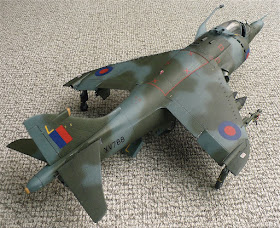








Here are some images of Airfix/Flight Path/Horizon 1/24 scale Hawker Siddeley/BEA Harrier GR3. From Wikipedia "
The Hawker Siddeley Harrier GR.1/GR.3 and the AV-8A Harrier are the first generation of the Harrier series, the first operational close-support and reconnaissance fighter aircraft with Vertical/Short Takeoff and Landing (V/STOL) capabilities, colloquially referred to as a "jump jet". The Harrier was the only truly successful V/STOL design of the many that arose from the 1960s.
In the 1970s, the Harrier was developed into the radar-equipped BAE Sea Harrier for the Royal Navy. The Harrier was also extensively redesigned as the BAE Harrier II and AV-8B Harrier II, which were built by British Aerospace and McDonnell Douglas.
The Harrier's lineage began with the Hawker P.1127. Design began in 1957 by Sir Sydney Camm, Ralph Hooper of Hawker Aviation and Stanley Hooker (later Sir Stanley) of the Bristol Engine Company. Rather than using rotors or a direct jet thrust the P.1127 had an innovative vectored thrust turbofan engine and the first vertical takeoff was on 21 October 1960. Six prototypes were built in total, one of which was lost at an air display.
The immediate development of the P.1127 was the Kestrel FGA.1, which appeared after Hawker Siddeley Aviation was created. The Kestrel's first flight was on 7 March 1964. It was strictly an evaluation aircraft, and only nine were built. These equipped the Tripartite Evaluation Squadron formed at RAF West Raynham in Norfolk, numbering 10 pilots from the RAF, USA and West Germany. One aircraft was lost and six of the remainder were transferred to the U.S. for evaluation by the Army, Air Force and Navy, designated XV-6A Kestrel.
At the time of the development of the P.1127, Hawker had started on a design for a supersonic version, the Hawker Siddeley P.1154. After this was cancelled in 1965, the RAF began looking at a simple upgrade of the Kestrel as the P.1127 (RAF).
An order for 60 production aircraft was received from the Royal Air Force in mid-1966, and the first pre-production Harriers, then known as the P.1127 (RAF), were flying by mid-1967, becoming known as Harrier GR.1.
The Hawker Siddeley Harrier GR.1 was the first production model derived from the Kestrel, it first flew on 28 December 1967, and entered service with the RAF on 1 April 1969. Construction took place at factories in Kingston upon Thames in southwest London and at Dunsfold, Surrey. The latter adjoined an airfield used for flight testing; both factories have since closed.
The ski-jump technique for STOVL used by Harriers launched from Royal Navy aircraft carriers was tested at the Royal Navy's airfield at RNAS Yeovilton (HMS Heron), Somerset. Their flight decks were designed with an upward curve to the bow following the successful conclusion of those tests.
The Harrier GR.3 featured improved sensors (such as a laser tracker in the lengthened nose), countermeasures and a further upgraded Pegasus Mk 103 and was to be the ultimate development of the 1st generation Harrier.
The AV-8As of the United States Marine Corps were very similar to the early GR.1 version, but with the more-powerful engine of the GR.3. The aircraft was powered by a 21,500 lbf (95.6 kN) thrust Roll-Royce Pegasus Mk 103 (F402-RR-402) turbofan engine. The AV-8A was armed with two 30 mm ADEN cannons (podded under the fuselage) and two AIM-9 Sidewinder air-to-air missiles. A total of 113 were ordered for the US Marines and the Spanish Navy.

No comments:
Post a Comment